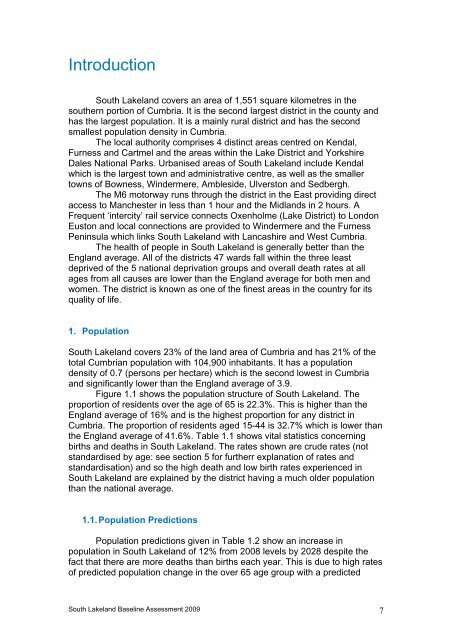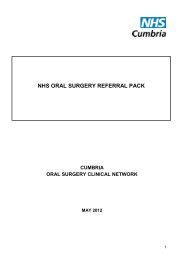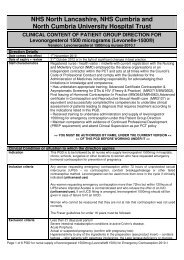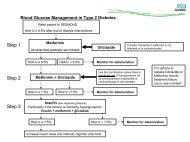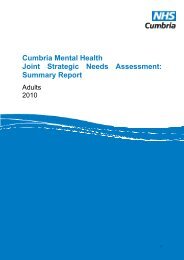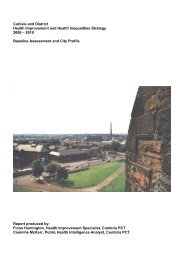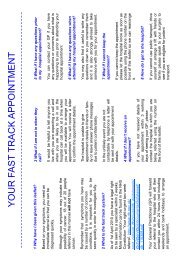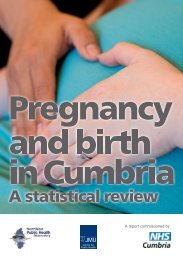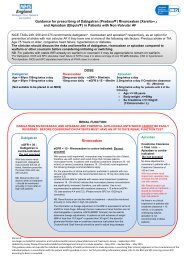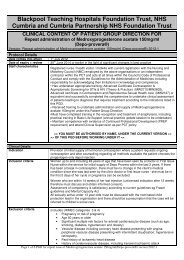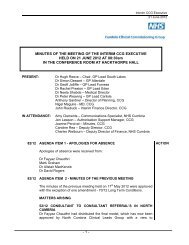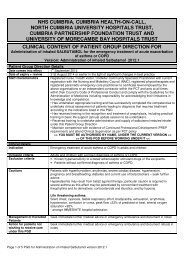South Lakeland Health Improvement Plan - NHS Cumbria
South Lakeland Health Improvement Plan - NHS Cumbria
South Lakeland Health Improvement Plan - NHS Cumbria
Create successful ePaper yourself
Turn your PDF publications into a flip-book with our unique Google optimized e-Paper software.
Introduction<strong>South</strong> <strong>Lakeland</strong> covers an area of 1,551 square kilometres in thesouthern portion of <strong>Cumbria</strong>. It is the second largest district in the county andhas the largest population. It is a mainly rural district and has the secondsmallest population density in <strong>Cumbria</strong>.The local authority comprises 4 distinct areas centred on Kendal,Furness and Cartmel and the areas within the Lake District and YorkshireDales National Parks. Urbanised areas of <strong>South</strong> <strong>Lakeland</strong> include Kendalwhich is the largest town and administrative centre, as well as the smallertowns of Bowness, Windermere, Ambleside, Ulverston and Sedbergh.The M6 motorway runs through the district in the East providing directaccess to Manchester in less than 1 hour and the Midlands in 2 hours. AFrequent ‘intercity’ rail service connects Oxenholme (Lake District) to LondonEuston and local connections are provided to Windermere and the FurnessPeninsula which links <strong>South</strong> <strong>Lakeland</strong> with Lancashire and West <strong>Cumbria</strong>.The health of people in <strong>South</strong> <strong>Lakeland</strong> is generally better than theEngland average. All of the districts 47 wards fall within the three leastdeprived of the 5 national deprivation groups and overall death rates at allages from all causes are lower than the England average for both men andwomen. The district is known as one of the finest areas in the country for itsquality of life.1. Population<strong>South</strong> <strong>Lakeland</strong> covers 23% of the land area of <strong>Cumbria</strong> and has 21% of thetotal <strong>Cumbria</strong>n population with 104,900 inhabitants. It has a populationdensity of 0.7 (persons per hectare) which is the second lowest in <strong>Cumbria</strong>and significantly lower than the England average of 3.9.Figure 1.1 shows the population structure of <strong>South</strong> <strong>Lakeland</strong>. Theproportion of residents over the age of 65 is 22.3%. This is higher than theEngland average of 16% and is the highest proportion for any district in<strong>Cumbria</strong>. The proportion of residents aged 15-44 is 32.7% which is lower thanthe England average of 41.6%. Table 1.1 shows vital statistics concerningbirths and deaths in <strong>South</strong> <strong>Lakeland</strong>. The rates shown are crude rates (notstandardised by age: see section 5 for furtherr explanation of rates andstandardisation) and so the high death and low birth rates experienced in<strong>South</strong> <strong>Lakeland</strong> are explained by the district having a much older populationthan the national average.1.1. Population PredictionsPopulation predictions given in Table 1.2 show an increase inpopulation in <strong>South</strong> <strong>Lakeland</strong> of 12% from 2008 levels by 2028 despite thefact that there are more deaths than births each year. This is due to high ratesof predicted population change in the over 65 age group with a predicted<strong>South</strong> <strong>Lakeland</strong> Baseline Assessment 2009 7


